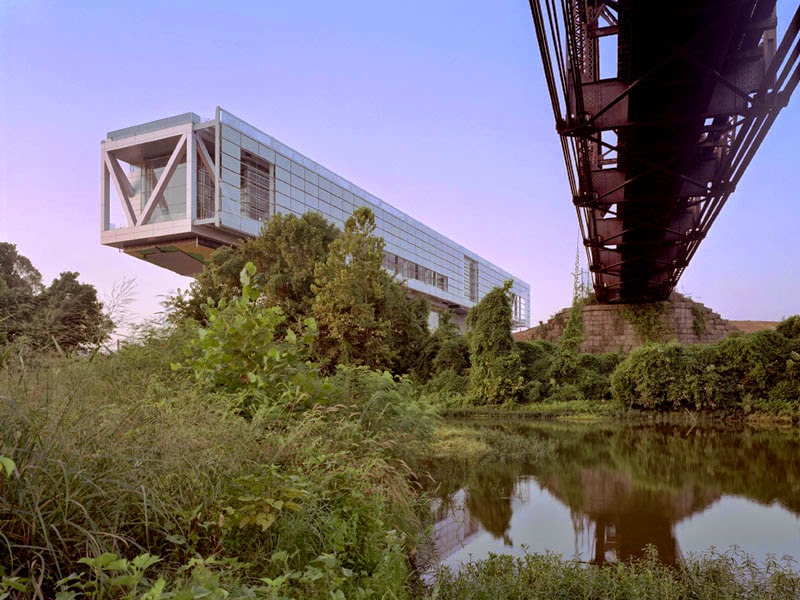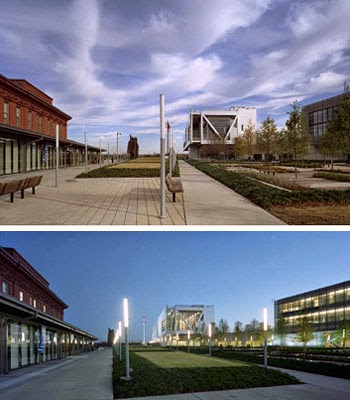Clinton Library
Clinton Library in Little Rock, Arkansas by Polshek Partnership
The design of the William J. Clinton Presidential Center can be attributed to four parties: the Polshek Partnership for the building architecture, Ralph Appelbuam Associates for the exhibition design, Hargreaves Associates for the landscape architecture, and of course Bill Clinton for being a visionary client. When presidential libraries tend towards the traditional and bombastic, Clinton opted for a restrained high-tech architecture, with integrated exhibitions, the whole taking strides to intelligently deal with its site, situated on the edge of the Arkansas River near downtown Little Rock.
Working with Clinton, the architects decided to situate the linear building perpendicular to the river, seemingly against the instinctive strategy that would parallel the building with the natural feature for views. By doing this, dramatic views are created to the east and west down the river, and - coupled with the 90-foot cantilever - the roughly 30-acre site continues along the water's edge unobstructed, and an arrival and celebration plaza ("scholar's garden") is created between the new structures and Choctaw Station, an 1880s renovated into the Clinton School of Public Service. Looking at the site and location plan, Hargreaves Associates exploited a 7-degree difference between the river's edge and the downtown street grid, a difference extended to the building's location.
James Polshek, along with partner Richard Olcott, designed both a metaphorical and a literal bridge, relating to the existing Rock Island Bridge (closed since 1980 but set to open soon as a pedestrian connection across the river) and Clinton's "Bridge to the 21st Century." The library/museum is contained in the "bridge", constructed as a truss with 30' structural bays that allow double-height spaces along its length. The presidential archive is contained in a landlocked structure south of the museum, partially underground for archival reasons, though it also helps to form the plaza between it and Choctaw Station. With Clinton's desire for transparency in the final design, the architects needed to balance this desire with the needs of the exhibitions (no direct light and stable ambient environment), something they achieved with a double facade and a custom laminated glass. Mechanical systems are located under the main floor of the museum, allowing for exhibition spaces without any distracting ducts.
Ralph Appelbaum Associates, known most for their exhibition design at the United States Holocaust Memorial Museum, was given the task of working within Polshek's design to exhibit the multitudes of presidential volumes and memorabilia in a manner fitting of Clinton's aims and the building design. Bound papers are collected in columnar shelves that exhibit the sheer scale of the presidency more than the content within. A canted wall acts as a timeline of Clinton's eight years, fitting with the linear arrangement of the architecture. A replica of the Oval Office at first seems out of place with the rest of the library and museum, but the way it's treated as an object celebrates its form while allowing it (internally) to keep the resemblance of its namesake. Like the rest of the museum it keeps one foot in the past while taking one step forward.
The design of the William J. Clinton Presidential Center can be attributed to four parties: the Polshek Partnership for the building architecture, Ralph Appelbuam Associates for the exhibition design, Hargreaves Associates for the landscape architecture, and of course Bill Clinton for being a visionary client. When presidential libraries tend towards the traditional and bombastic, Clinton opted for a restrained high-tech architecture, with integrated exhibitions, the whole taking strides to intelligently deal with its site, situated on the edge of the Arkansas River near downtown Little Rock.
Working with Clinton, the architects decided to situate the linear building perpendicular to the river, seemingly against the instinctive strategy that would parallel the building with the natural feature for views. By doing this, dramatic views are created to the east and west down the river, and - coupled with the 90-foot cantilever - the roughly 30-acre site continues along the water's edge unobstructed, and an arrival and celebration plaza ("scholar's garden") is created between the new structures and Choctaw Station, an 1880s renovated into the Clinton School of Public Service. Looking at the site and location plan, Hargreaves Associates exploited a 7-degree difference between the river's edge and the downtown street grid, a difference extended to the building's location.
James Polshek, along with partner Richard Olcott, designed both a metaphorical and a literal bridge, relating to the existing Rock Island Bridge (closed since 1980 but set to open soon as a pedestrian connection across the river) and Clinton's "Bridge to the 21st Century." The library/museum is contained in the "bridge", constructed as a truss with 30' structural bays that allow double-height spaces along its length. The presidential archive is contained in a landlocked structure south of the museum, partially underground for archival reasons, though it also helps to form the plaza between it and Choctaw Station. With Clinton's desire for transparency in the final design, the architects needed to balance this desire with the needs of the exhibitions (no direct light and stable ambient environment), something they achieved with a double facade and a custom laminated glass. Mechanical systems are located under the main floor of the museum, allowing for exhibition spaces without any distracting ducts.
Ralph Appelbaum Associates, known most for their exhibition design at the United States Holocaust Memorial Museum, was given the task of working within Polshek's design to exhibit the multitudes of presidential volumes and memorabilia in a manner fitting of Clinton's aims and the building design. Bound papers are collected in columnar shelves that exhibit the sheer scale of the presidency more than the content within. A canted wall acts as a timeline of Clinton's eight years, fitting with the linear arrangement of the architecture. A replica of the Oval Office at first seems out of place with the rest of the library and museum, but the way it's treated as an object celebrates its form while allowing it (internally) to keep the resemblance of its namesake. Like the rest of the museum it keeps one foot in the past while taking one step forward.










Comments
Post a Comment
Comments are moderated for spam.